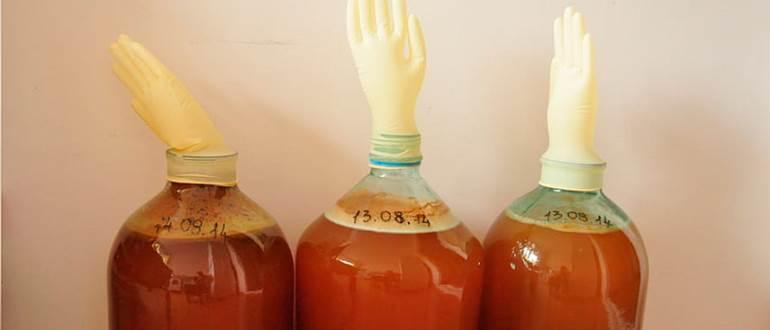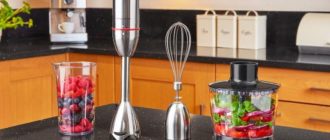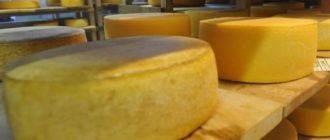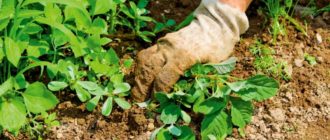Wine has long been considered a very noble drink. Find a good and high-quality brand in the store today is very rare, besides it will cost quite expensive. Especially since it is summer, and making wine on your own is not as difficult as it might seem at first glance. If you correctly approach this issue, the output will be quite tasty and moderately alcoholic drink. It will be characterized by a harmonious aftertaste, pleasant aroma and other positive qualities that distinguish a good wine.
If you have never before been involved in home winemaking, then this article will be very useful for you. Here we not only collected the best recipes of homemade wine of 2019, but also plan to talk about the varieties of this drink and the key rules for its preparation.
Summary of the rating:
What is homemade wine and what can it be made from?
In principle, all wines, regardless of their origin, are divided into three main groups - fruit, berry and grape. Fruit fruits are made from pears, apples or other similar fruits. Berry wine can be made absolutely from any kind of berries, both garden and wild origin. Naturally, home-made grape wines are the most popular - there are a lot of varieties: dry, sweet, semi-sweet, dessert, white or red. Each person in the field of preparing their own wine can give absolute freedom to their imagination. The main thing here is to correctly observe the dosage or ratio of wine material, sugar and water, and also allow the mixture to ferment for the required time, and then withstand it subject to certain storage conditions.
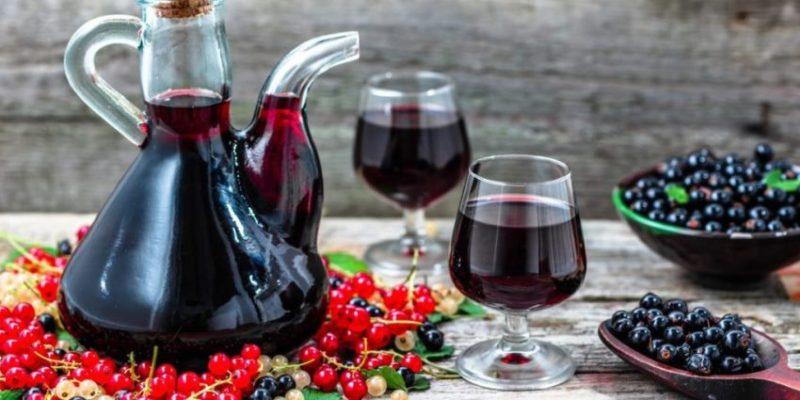
Most recipes use a design such as a water trap. You can easily assemble it yourself, although there are already ready-made designs on sale. To do this, you will need to take an ordinary plastic cover, make a hole in it. A rubber or plastic hose is inserted there, the connection itself is carefully sealed (you can use even the most ordinary silicone sealant). The other end of the hose is lowered into a container of water. A water trap will not allow air to enter the container with future wine and slow down or completely stop the fermentation process.
When choosing the best homemade wine recipes for inclusion in our review today, we were mainly guided by user reviews, including quite experienced winemakers who have been engaged in winemaking for quite some time. We hope that after studying the rating, you can choose the most preferred recipe for yourself, and the resulting wine will be to the taste of both you and your guests, whom you decide to treat them.
Best Homemade Wine Recipes
10. Strawberry Wine

It has a fairly simple manufacturing technology, so even a novice winemaker who has not dealt with similar products before can make it. The result should be a drink, the strength of which will be about 10-12% (as with the standard wine found on sale). To make the wine more fragrant, forest strawberries can be added to it instead of a portion of strawberries.In this case, it will be possible to provide increased saturation of taste. If you store the drink in a cool and darkened room, then its average shelf life will be about two to three years. However, there is some trick here - in addition to berries, water and sugar, you will need to add a certain amount of unwashed raisins. With its help, the fermentation process will become more active and longer, which will significantly increase the strength of the drink.
To make such a wine, you need to take three parts of berries, three parts of water, two parts of granulated sugar and 30 grams of raisins for every kilogram of strawberries. All berries are washed thoroughly (strawberries grow directly near the surface of the earth, so a large amount of dust accumulates on it), the stalks are removed. Then they need to be folded into a glass or enameled dish and thoroughly knead with a wooden spoon or rolling pin until gruel condition. It is worth mentioning that it is strictly forbidden to use aluminum pans or metal spoons for these purposes, since the berries will immediately oxidize, which will negatively affect the fermentation process.
Before adding to the berries, it is advisable to warm the water to a temperature of 30 degrees - during this process sugar is added to it and thoroughly mixed. It is most convenient to use 3-liter cans as a fermentation tank. When water and berries are directly in the jar, it is necessary to add raisins. First, the container is loosely closed with a plastic cover or a layer of gauze, set it in a dark warm place with a temperature of about 20-25 degrees and leave for 6-7 days. They mix future wine with a wooden spoon once a day so that it does not turn sour. Then they filter everything, add another 250 grams of sugar per liter of the resulting starter culture, install a water seal and leave to ferment for another three to four weeks. When carbon dioxide ceases to escape through the water trap, this means that the wine is ready. It is carefully poured into glass bottles, making sure that the precipitate does not get there, they are tightly corked and cleaned in a dark cool place for another three months, after which the wine can be consumed.
Benefits:
- Easy to prepare;
- Fragrant and fragrant;
- The fortress is the same as that of ordinary grape wine.
Disadvantages:
- Strawberries themselves are not too prone to fermentation, so you need to add raisins, which will stimulate this process.
9. Blackcurrant wine
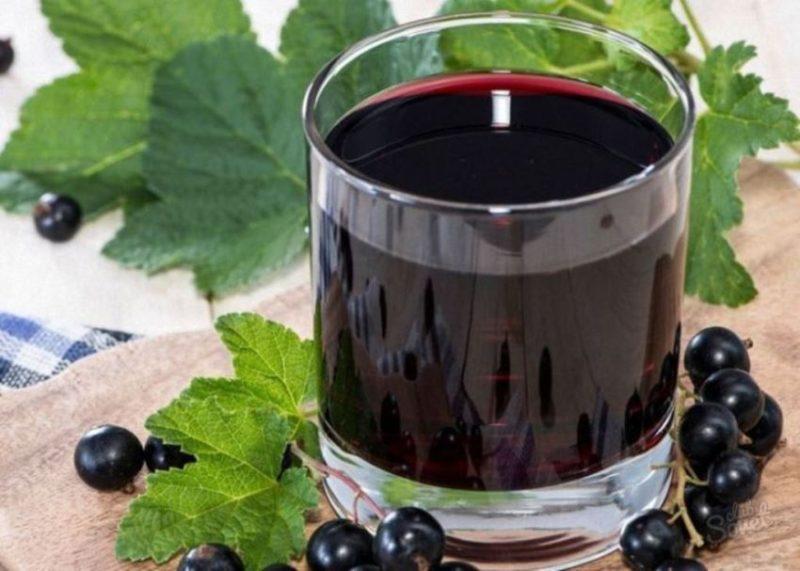
At the very first stage, the berries from which the drink will be prepared should be carefully sorted and cleaned of debris, twigs, leaves. This process will need to be paid close attention, since it is impossible to wash the fruits, because on the surface of the berries there is a large amount of natural yeast, with the help of which the natural fermentation process is launched. Due to it, the original taste and unique aroma of the drink is formed. You do not have to prepare the leaven. The quantity of ingredients here is small - 7 parts of water and 2.5-3 parts of sugar are taken for 5 parts of berries. As in the previous recipe, the berries should first be crushed, the water is slightly heated and half of the sugar mass is dissolved in it. The crushed berries are thoroughly mixed with the resulting syrup. This is done in a wide-necked container. It should be filled in such a way that a certain amount of free space remains, otherwise the wort can overflow over the edge during fermentation.
The neck of the dishes is covered with gauze and left for a couple of days in a warm and dark place. A couple of times a day, future wine should be thoroughly mixed with a wooden spoon or just by hand. When gas begins to form and bubbles form, the wort is very carefully drained from the sediment. The remaining berries after draining the wort should be squeezed carefully and add it to the already drained liquid.Now it is most convenient to put wine for fermentation in dishes with a narrow neck - it is easier to attach a water lock on it, and it will take up much less space. Maintain in this position for a month. About once every ten days you need to add 200 grams of sugar per 1 liter of wine. This will make the wine fragrant and pleasant to the taste, with a slight acidity. Next, the drink is bottled and left to mature for three months.
Benefits:
- It is made only from berries, water and sugar;
- Subject to technology, it will be possible to obtain a delicate and very tasty aperitif;
- Not very high strength, if desired, it can be increased by fixing the wine with vodka or alcohol.
Disadvantages:
- If sugar is not added in time during fermentation, the wine will turn sour.
8. Plum wine
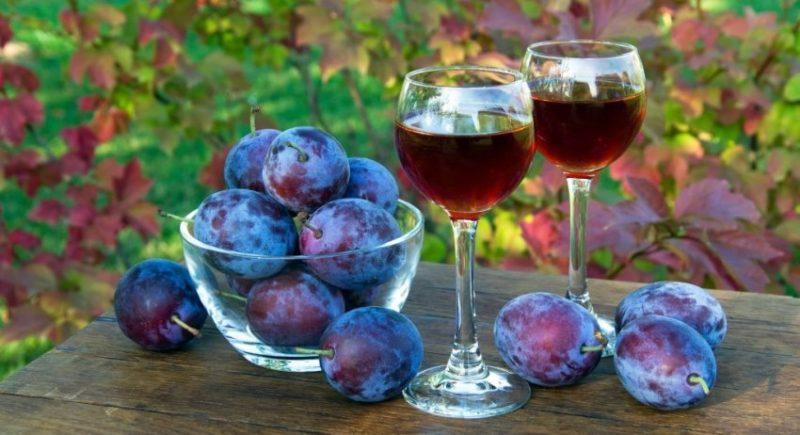
It is unlikely that anyone will turn their tongue to call home-made plum wine an elite alcoholic drink, but at the exit, with a competent approach to business, a very interesting aromatic bouquet and original taste should be obtained. It will appeal to even lovers of a rather expensive wine. Plum wine goes well with meat or dessert dishes, and the amount of sugar can be adjusted during the preparation of the drink. The most difficult thing is to get juice from the fruits. This is due to the fact that a large percentage of pectin is in the plum, which makes the fruits jelly-like. However, it contains a lot of sugar, so making wine from it is much more economical and easier than, say, from the same apples. Sugar will have to add a lot less, and fermentation is very active. The proportions are as follows - 10 parts of mashed plum, which must first be peeled, 1 part of water and 100-200 grams per kilogram of pulp.
For the preparation of wine, any fruits of dark varieties are suitable. First, the fruits need to be kneaded with a wooden spoon in an enameled bowl and diluted with ordinary cool water in a 1: 1 ratio. Leave the mixture for two days in a dark place at a temperature of no higher than 25 degrees, it will need to be stirred from time to time. After this time, the wort is passed through cheesecloth or a fine mesh to get rid of the pulp. Now sugar is added, and you do not need to immediately add the entire volume. First, about half of the required amount is filled up, then thoroughly mixed, a water seal is installed and returned to a warm dark place to start the fermentation process. The remaining sugar should be added approximately 25% of the remaining mass every 4-5 days. Plum wine can ferment up to 60 days - this is monitored by a water seal. The fermented, strained and bottled wine matures within two to three months.
Benefits:
- Uncomplicated technology;
- Ruby color of the drink;
- Suitable for many dishes.
Disadvantages:
- You need to accurately track the time of adding sugar, otherwise it can lead to an increase in the acidity of the drink.
7. Raspberry wine

Despite the fact that these berries contain a large amount of yeast, the wine does not ferment very much, which makes the drink not too alcoholic - its average strength is in the range of 8 to 10%. For the preparation of products you will need to use 1 part of berries, 1 part of water and 0.5 parts of sugar. Wine is made only from the most ripe berries. Some winemakers use a meat grinder to grind them, but we do not recommend doing this, because when in contact with metal, berry puree will absorb foreign odors, which, ultimately, cannot but affect the final taste of the wine. It is best to use an ordinary rolling pin for this. The resulting slurry is transferred to a well-washed glass container, filling it by about two-thirds. 0.7 parts of water and 0.6 parts of sugar are added there.
You don’t have to pre-insist on the must: a water lock is immediately put on the container (many winemakers use an ordinary medical rubber glove instead, where in one finger they make a puncture with a thin needle to remove carbon dioxide). The most active fermentation process lasts for 7-10 days, after which the wort is filtered through several layers of gauze, squeeze out the remaining pulp, add another 0.3 parts of water and the remaining sugar. Re-close with a water seal or glove, and then leave for another month and a half. When the glove is completely blown away, this will mean that the wine is ready, in addition, it will become much brighter than it was originally. The drink will need to ripen within 3-6 months, if desired, it can be fixed. There is an important trick: in the process of filling the bottles are filled as fully as possible so that the minimum amount of air remains in them.
Benefits:
- Light and pleasant wine;
- Easy to prepare;
- Long shelf life - can reach 3-4 years.
Disadvantages:
- In order for the taste to fully unfold, the drink must be aged for a rather long time.
6. Gooseberry wine

In order for this drink to be optimal in terms of taste, the following recommendations must be followed: wine is prepared exclusively from ripe, but not overripe berries. Previously, they should be carefully inspected so that they do not have mold and other defects. For the preparation of quality wine you need to use only freshly picked gooseberries - no more than 20 hours should pass from the time of collection. Berries should not be washed. They make wine only in glassware, which will not only have to be thoroughly washed, but also sterilized. Getting juice from gooseberries is not as easy as it might seem at first glance, so water is often added to mashed berries. For 1 kg of berries add no more than 250 ml of water, instead of it you can use raspberry or currant juice - in this case, the wine will acquire additional berry notes and will become even more pleasant to the taste.
Pouring the pulp of berries with ordinary water is possible, but because of this, the fermentation process will be much slower - for this, it is better to prepare syrup by dissolving a certain amount of sugar: 300 kg to 500 grams of berries are taken per 1 kg of berries, depending on the sweetness of the berries. If there is too much sugar, the wine will be sugary, and the taste will become much weaker. If the technology is followed correctly, in just a couple of days, characteristic hissing and gurgling will be heard from the tank, which will inform about the beginning of the active stage of the fermentation process, which lasts from 25 to 45 days. As you can see, gooseberry wine is prepared quite quickly. Closer to completion, the composition will become lighter, and some sediment will form at the bottom. Subsequently, the wine is poured into a glass container, making sure that no sediment gets there. Store it in a cool place, keeping for two to three months, after which it will be ready for use.
Benefits:
- You can add the juice of other berries to improve the taste;
- It roams quite actively and quickly;
- Very easy to drink.
Disadvantages:
- Long preparation of berries.
5. Apricot wine
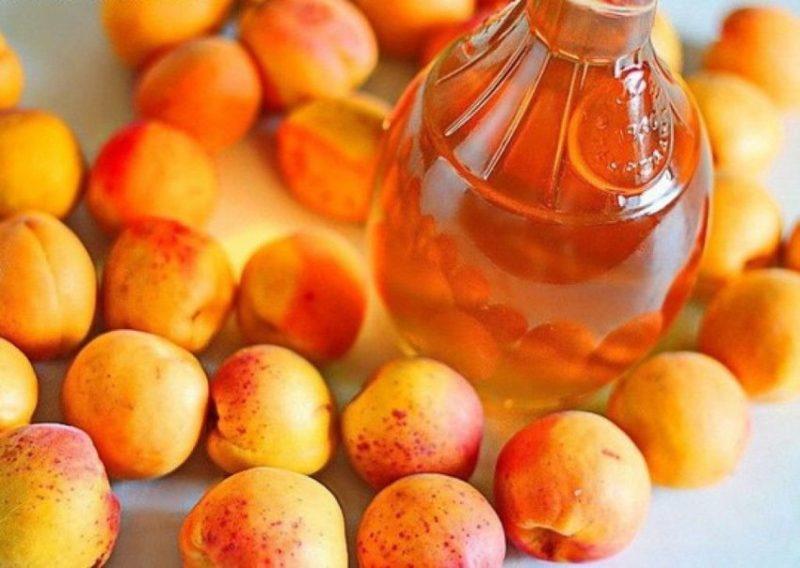
Apricots grow on trees, so there is usually no dirt on them, however, rains and wind do their job, which is why a large amount of dust accumulates on them. To get rid of it before making wine, you should not wash the berries - they will have to be wiped with a soft, dry cloth. Be sure to remove seeds from apricots. You can’t put wine with them, since they contain a large amount of hydrocyanic acid, which makes the drink harmful or even dangerous for human health. It is advisable to select the most ripe and juicy fruits for wine.
Knead them with your hands until a homogeneous liquid mass is obtained.Then they put the berries in a bulk container, add water in a proportion of 0.5 part liquid to 1 part apricots, sugar is added here - 0.3 kg per 1 kg of berries. In general, in terms of sugar, the question is individual: it depends on the juiciness and sweetness of the variety. Due to the fact that the apricots themselves are very juicy, there is no need to additionally prepare syrup. Sugar will disperse in the resulting mixture. Then the container is covered with gauze and put for about 5 days in a dark warm place, mix the composition two or three times a day with a wooden spoon or simply by hand. The first signs of fermentation occur on the first day. After filtering and installing a water seal, the wine should ferment for another two months. Five days after the water seal was put in, some more sugar was added at the rate of 300 grams per 1 liter of future wine. All other actions are the same as for the other recipes discussed above in our review today.
Benefits:
- A gentle and pleasant drink with refreshing notes;
- It can be stored in a cool place up to 5 years;
- Ideally suited not only for desserts, but can also be used as an aperitif.
Disadvantages:
- It can be difficult to calculate the right amount of sugar.
4. Zucchini wine
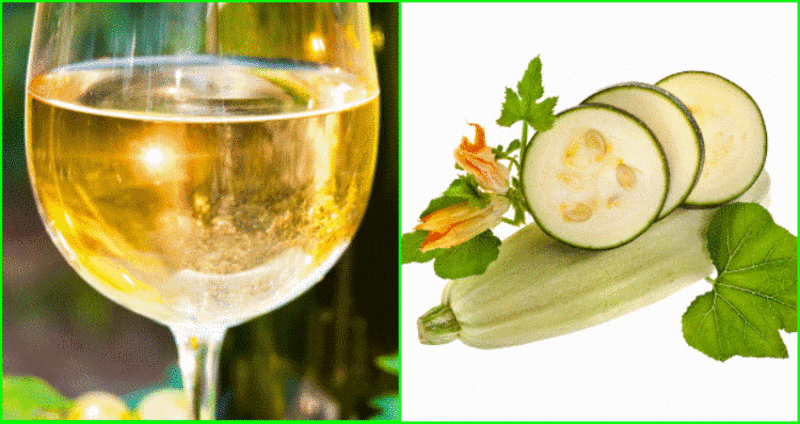
A very original drink, which has a subtle taste of fresh herbs and a light pleasant aroma. Typically, this wine has a yellowish cloudy color with some shares of green. To prepare this interesting wine, you need to take two kilograms of ripe zucchini, 4 l of water, three lemons, 1 kg of sugar and 50 g of raisins. The recipe is a bit complicated, so it will suit more experienced winemakers. First you need to prepare a special wine starter - raisins are poured into 150 ml of water and 25 g of sugar is added. All this is thoroughly mixed, tied with gauze and put in a dark warm place. It usually takes 2-3 days to make the starter. When this time has passed, the zucchini cut and take out the seeds and core from them. Then they are crushed (there are not very many acids in this vegetable, so you can skip them through a meat grinder). The gruel is placed in an enameled pan, poured with boiling water, covered with a lid and left for a day.
Filter the contents, squeeze the flesh. In the resulting liquid make 0.5 kg of sugar, lemon, sourdough and mix thoroughly. After that, fill the container with two-thirds of the compounds, install a water seal or glove and leave to roam. It should be noted that the fermentation process should occur at a temperature of 18 to 29 degrees. Five days later, about half a liter of wort is poured, 250 grams of sugar are diluted in it and poured back. This procedure is repeated twice more - every 5 days. Depending on the temperature, the fermentation process can last from 25 to 60 days. If desired, the drink is fixed (the addition of alcohol does not affect the taste at all) and sent to insist in coolness for about 3-4 months. During this time, approximately once a month you will have to drain the wine from the lees.
Benefits:
- Additional alcohol during fastening is not felt;
- Light and very tasty drink.
Disadvantages:
- Relatively sophisticated cooking technology.
3. Cherry wine
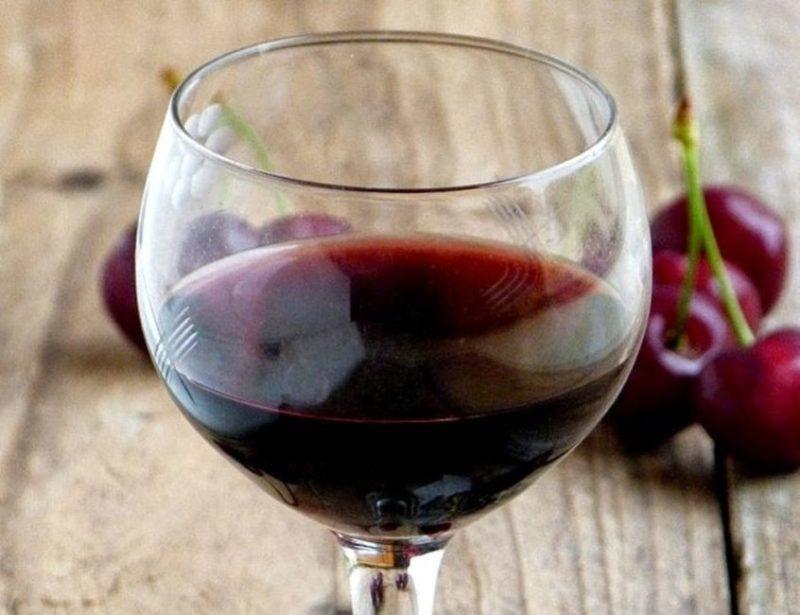
Dark sour cherry is best suited for such a drink. If it is not available, you can use any ripe berries of this type. They are carefully sorted out, removing damaged and affected by putrefactive processes. The containers are washed, scalded with boiling water and wiped dry with a soft cloth. Most seeds should be removed, however, to get a more astringent taste, a small amount can be added to the must (unlike apricot kernels, there is practically no hydrocyanic acid, so there will be no harm to health). The optimal composition of the ingredients is as follows - 3 kg of ripe berries, already peeled; 4 l of water and 1.5 kg of sugar. Water is heated to a temperature of 25-29 degrees, pour cherry on it.After that add a third of the required amount of sugar, mix everything very well and put in a dark, dry place for 3-5 days. The temperature should be kept at least 18 degrees.
The first signs of fermentation appear during the first day. The resulting foam is removed by stirring. Then the whole composition is drained, filtered, the pulp of berries must be squeezed out carefully, the juice added to future wine, and the cake thrown away. At this stage, another 0.5 kg of sugar is added, everything is put back into the dishes for fermentation, and a water seal is placed. After another five days, add the remaining sugar. In this form, the wine should ferment until the very end - it will take about a month and a half. In the process of bottling, you must try the wine. If it turns out to be a little sour, you can add a little more sugar to it. Cherry wine matures quite a long time - from 6 to 12 months. Only in this case its taste and aroma are fully revealed.
Benefits:
- Tasty wine with a slight acidity and a soft berry aftertaste;
- It can be used as an aperitif, along with fish and meat dishes, as well as with dessert.
Disadvantages:
- It’s hard not to make a mistake with the time of adding sugar.
2. Apple wine
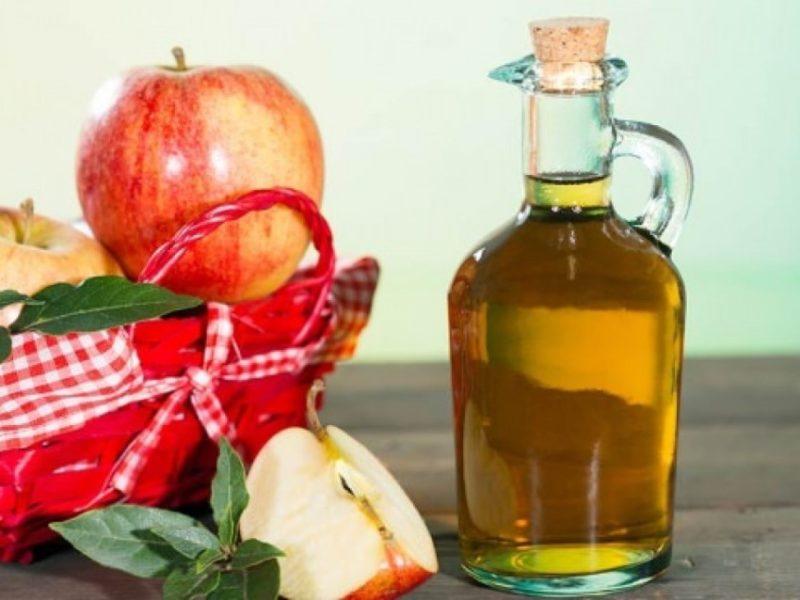
The average strength of such a drink with proper preparation is 10-12 degrees, and the recipe for preparation is quite simple. However, you should immediately make a reservation that you will have to process a lot of apples - 20 kg, sugar is added at the rate of 150-200 grams per 1 liter of juice. Fruits should not be washed, just wipe. They need to be cleaned of seeds and core, otherwise some bitterness may occur. Now juice is extracted from apples - you can use an ordinary juicer. Its main working elements are made of stainless steel, which does not oxidize and does not absorb extraneous odors, so the juice will have its original taste. The resulting product is left for two to three days in an open container with a fairly wide neck, which must be bandaged with gauze. The first two days, three to four times a day, you need to mix the composition.
On the third day, all solid particles remaining in the juice will accumulate on the surface. They are removed, squeezed and discarded. As a result, only the juice itself and a small film will remain in the container, the thickness of which should not exceed 3-5 mm. Take into account which kind of apples used to make wine. The sweeter the fruits, the less sugar you need to add there. If there is too much sugar, the process will either slow down or stop altogether. First, it is added about 300 grams before installing a water seal, then every 3-5 days in the same amount, but wine will first need to be tasted. If it gets too sweet, it means that sugar is no longer needed. Now the drink is left to ferment until the end. Then it is filtered, drained and removed to insist. This process usually takes three to four months.
Benefits:
- Easy-to-drink drink with a pleasant aftertaste, in which even some floral notes are observed;
- Ease of preparation;
- Not too long insisted.
Disadvantages:
- It is necessary to monitor the level of sweetness of the wine so as not to spoil it.
1. Homemade grape wine
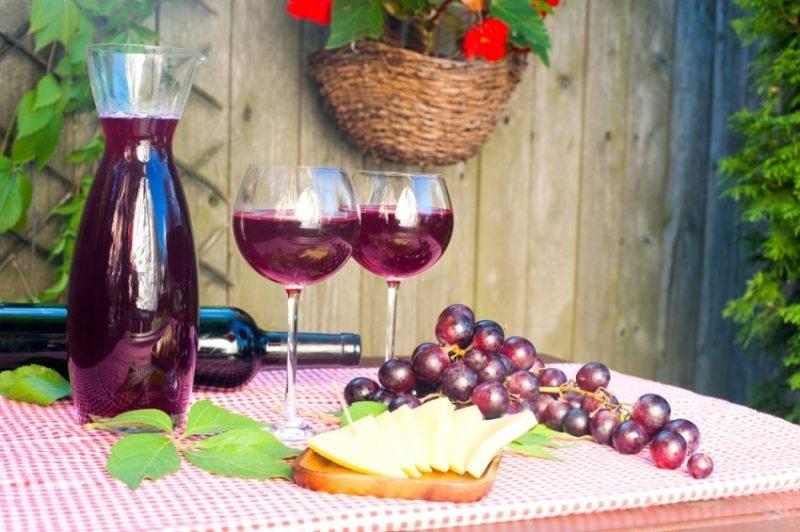
It is only natural that the classic grape wine came first in our ranking. Cooking it is not so simple, however, if you follow the technology exactly, you will get just a great drink. For this wine you will need about 10 kg of berries, taken from bunches, from 50 to 200 grams of sugar per 1 liter of juice, practically no water is added (up to 500 ml per 1 liter of juice, and in the most exceptional cases), since it is not only it can significantly slow down fermentation, but also worsen the taste of the drink. For wine, only the most ripe berries picked in dry sunny weather are suitable, and there should not be rains two or three days before harvesting.Otherwise, moisture will wash away wild yeast formed on the peel. All berries are carefully sorted, removing unripe, rotten. It is most convenient to crush them with a rolling pin in an enameled bowl. Experienced winemakers recommend doing this even with your hands, so that all the bones remain intact, otherwise the wine may begin to bitter.
The crushed berries are stacked in a wide-necked dish and covered with gauze or another similar cloth. Stir regularly, otherwise the wort can become sour. After two to three days, the juice that started to ferment is poured, the berries are squeezed, the juice is passed through the gauze layers several times. This allows you to saturate it with oxygen, providing nutrition to wine yeast. Everything else is standard - a water trap and a dark warm place for fermentation. Sugar is added about once a week in small quantities, after tasting how sweet the wine is. Immediately after stopping the fermentation, the drink should not be poured, it is better to wait a couple more days. This will help the sediment sink to the bottom of the tank. The wine ripens within 40-380 days. During this time, the drink acquires a complete taste and color.
Benefits:
- Subject to technology, classic wine is obtained;
- With this recipe you can get a drink of various types - white, red, dry, semi-sweet, dessert wine;
- Long storage period.
Disadvantages:
- To properly prepare this wine, you need to be a very experienced winemaker.
In conclusion, a useful video
So we told you about the most common and simple recipes for homemade wine. We tried to paint each of them as detailed as possible, so that the first time you get a decent drink, which is not ashamed to treat guests or relatives. If you still have some questions, then you can always ask them to us, we will quickly respond to them and provide the information you are interested in.

